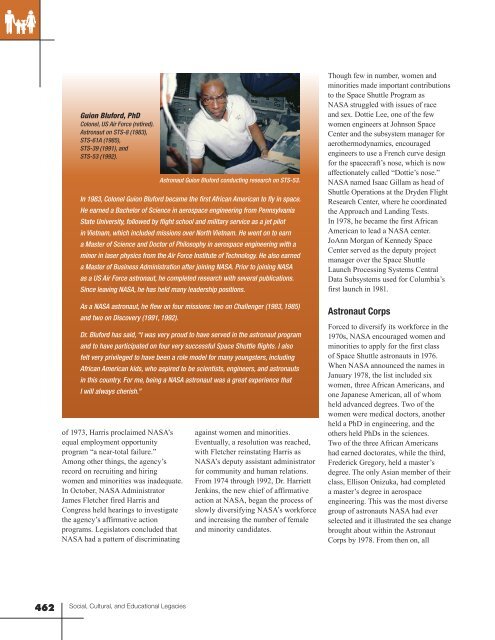Social, Cultural and Educational Legacies - ER - NASA
Social, Cultural and Educational Legacies - ER - NASA
Social, Cultural and Educational Legacies - ER - NASA
You also want an ePaper? Increase the reach of your titles
YUMPU automatically turns print PDFs into web optimized ePapers that Google loves.
Guion Bluford, PhDColonel, US Air Force (retired).Astronaut on STS-8 (1983),STS-61A (1985),STS-39 (1991), <strong>and</strong>STS-53 (1992).In 1983, Colonel Guion Bluford became the first African American to fly in space.He earned a Bachelor of Science in aerospace engineering from PennsylvaniaState University, followed by flight school <strong>and</strong> military service as a jet pilotin Vietnam, which included missions over North Vietnam. He went on to earna Master of Science <strong>and</strong> Doctor of Philosophy in aerospace engineering with aminor in laser physics from the Air Force Institute of Technology. He also earneda Master of Business Administration after joining <strong>NASA</strong>. Prior to joining <strong>NASA</strong>as a US Air Force astronaut, he completed research with several publications.Since leaving <strong>NASA</strong>, he has held many leadership positions.As a <strong>NASA</strong> astronaut, he flew on four missions: two on Challenger (1983, 1985)<strong>and</strong> two on Discovery (1991, 1992).Dr. Bluford has said, “I was very proud to have served in the astronaut program<strong>and</strong> to have participated on four very successful Space Shuttle flights. I alsofelt very privileged to have been a role model for many youngsters, includingAfrican American kids, who aspired to be scientists, engineers, <strong>and</strong> astronautsin this country. For me, being a <strong>NASA</strong> astronaut was a great experience thatI will always cherish.”of 1973, Harris proclaimed <strong>NASA</strong>’sequal employment opportunityprogram “a near-total failure.”Among other things, the agency’srecord on recruiting <strong>and</strong> hiringwomen <strong>and</strong> minorities was inadequate.In October, <strong>NASA</strong> AdministratorJames Fletcher fired Harris <strong>and</strong>Congress held hearings to investigatethe agency’s affirmative actionprograms. Legislators concluded that<strong>NASA</strong> had a pattern of discriminatingAstronaut Guion Bluford conducting research on STS-53.against women <strong>and</strong> minorities.Eventually, a resolution was reached,with Fletcher reinstating Harris as<strong>NASA</strong>’s deputy assistant administratorfor community <strong>and</strong> human relations.From 1974 through 1992, Dr. HarriettJenkins, the new chief of affirmativeaction at <strong>NASA</strong>, began the process ofslowly diversifying <strong>NASA</strong>’s workforce<strong>and</strong> increasing the number of female<strong>and</strong> minority c<strong>and</strong>idates.Though few in number, women <strong>and</strong>minorities made important contributionsto the Space Shuttle Program as<strong>NASA</strong> struggled with issues of race<strong>and</strong> sex. Dottie Lee, one of the fewwomen engineers at Johnson SpaceCenter <strong>and</strong> the subsystem manager foraerothermodynamics, encouragedengineers to use a French curve designfor the spacecraft’s nose, which is nowaffectionately called “Dottie’s nose.”<strong>NASA</strong> named Isaac Gillam as head ofShuttle Operations at the Dryden FlightResearch Center, where he coordinatedthe Approach <strong>and</strong> L<strong>and</strong>ing Tests.In 1978, he became the first AfricanAmerican to lead a <strong>NASA</strong> center.JoAnn Morgan of Kennedy SpaceCenter served as the deputy projectmanager over the Space ShuttleLaunch Processing Systems CentralData Subsystems used for Columbia’sfirst launch in 1981.Astronaut CorpsForced to diversify its workforce in the1970s, <strong>NASA</strong> encouraged women <strong>and</strong>minorities to apply for the first classof Space Shuttle astronauts in 1976.When <strong>NASA</strong> announced the names inJanuary 1978, the list included sixwomen, three African Americans, <strong>and</strong>one Japanese American, all of whomheld advanced degrees. Two of thewomen were medical doctors, anotherheld a PhD in engineering, <strong>and</strong> theothers held PhDs in the sciences.Two of the three African Americanshad earned doctorates, while the third,Frederick Gregory, held a master’sdegree. The only Asian member of theirclass, Ellison Onizuka, had completeda master’s degree in aerospaceengineering. This was the most diversegroup of astronauts <strong>NASA</strong> had everselected <strong>and</strong> it illustrated the sea changebrought about within the AstronautCorps by 1978. From then on, all462<strong>Social</strong>, <strong>Cultural</strong>, <strong>and</strong> <strong>Educational</strong> <strong>Legacies</strong>
















